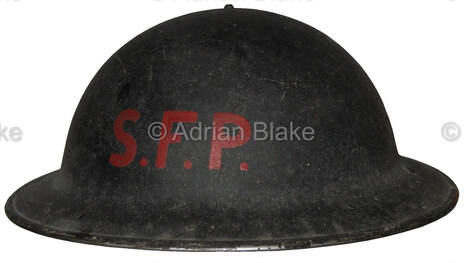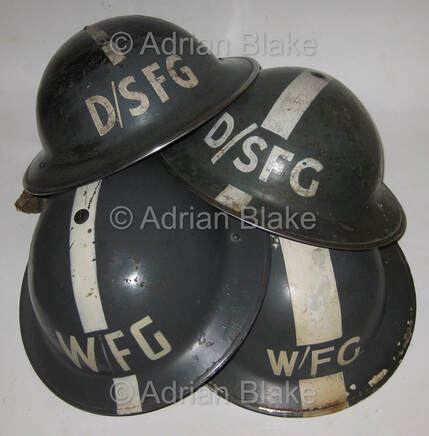Guest blog entry by Adrian Blake - Fire Parties, Fire Watchers and Fire Guards and their helmets11/25/2020 It was once assumed that gas attacks would be the main threat to civilians during the second world war but it soon became apparent that fire would be the main enemy on the Home Front. As a result, Fire Parties and Fire Watchers stood by in their millions, armed with just a helmet, a stirrup pump and a bucket of sand in most cases. Their role was to spot, report and, if they could, neutralise the threat. Helmets, either the Civilian Protective Helmet (“Zuckerman”) or one of the Mk. II types, were often marked ‘SFP’, ‘FW’ or just ‘FP’. These markings are therefore probably the most numerous of all applied during the war. There were two groups which operated under the ‘SFP’ banner, although in reality both undertook the same tasks. The main difference was one of recruitment with Street Fire Parties being recruited and trained by the Wardens’ Service to cover their local area whilst Supplementary Fire Parties were organised by the Fire Service. Despite this they are often referred to in the same breath. In LRC No. 324 (6 March, 1941) the Chief Administrative Officer, states “Where supplementary (street) fire parties are given helmets, the letters “S.F.P.” should be painted in black at the front and rear of the helmet.” Supplementary Fire Party members were issued with blue armbands with ‘SFP’ in red in 1940 and the use of red sometimes extended to the markings on helmets (see above) whilst they were still under the control of the Fire Service. The provision of helmets was another matter, with one part of the SFP having them provided as part of the ARP Storage and Loan of Equipment Regulations, whilst the other part had to provide their own. The two sets of parties operated alongside one another for a while and it is probably fair to say they operated below par. Recruitment and leadership were less than satisfactory despite a rallying call by Herbert Morrison in late 1940. In addition, with the Wardens’ Service, the Local Authorities and the Fire Service, there were too many bosses. Changes came on 6 August, 1941 with the introduction of the Fire Guard. Those who joined the Local Authority Fire Guard were instructed to overpaint their ‘SFP’ helmet markings and replace them with ‘FG’ in white, whilst those who didn’t retained their old markings. This means that some helmets retained their original grey base colour with “FG” in white on the front whilst others, belonging to ex-SFP members, will have been less consistent. In addition to the SFP, Fire Watchers were also looking out for fires although, at first, they lacked organisation and structure. It wasn’t long before simply looking out for fires wasn’t enough. The risk to commercial premises was too great and in September 1940, under the Fire Watchers Order, the role was formalised. Later, in 1941, the Government wanted to “knit together the Fire Watchers in the residential areas and thus to constitute them into a homogeneous and effective organisation” (HSC 174 / 1941, 6/8/41). It was deemed important that this new group should recognise that they were delivering an “important national duty” and as such they too received a new collective identity as the Fire Guard, operating as part of the Wardens’ Service. Theoretically at least, helmet markings should have then undergone a large-scale refresh but whilst the aforementioned communication touched lightly on the replacement of armlets (‘FIRE GUARD’ replaced ‘SFP’) no mention was made of helmets or their markings. However, that same year, where people previously with a Fire Party became a member of the local authority Fire Guard, they were instructed to repaint their helmets and apply ‘FG’ in place of ‘SFP’. This became the first iteration of the Fire Guard. The use of ‘W’ for the senior ranked Fire Guards was deemed inappropriate so a hybrid marking ‘W(F.G.)’ was agreed and this was communicated via HSC 139/1942 on 9 July, 1942. In London, seniority was represented by a white stripe (one inch and two inches wide) on grey helmets and these were marked ‘W/FG’ front and back (LRC No. 705 27/10/42 – consolidated). Unsurprisingly, variants exist as shown in this grouping. It was standard practise to mark helmets of deputies with the same markings as their bosses as their role was to stand in for the senior rank as required. However, records show on more than one occasion seniors didn’t appreciate “their” markings being shared with subordinates. In the case of this collection, not only has a “D” (Deputy) been added for clarity but a new unofficial thinner stripe has been introduced. This resulted in two different stripe widths for the same role. The 1-inch stripe was worn by the Senior Fire Guard and the 2-inch stripe by the Head Fire Guard. Other rank markings are perhaps more common, although the upper echelons are understandably harder to find nowadays.
The Fire Guard was to undergo a further change in 1943 when it was detached from the Wardens’ Service to stand alone (HSC No. 23/43). A totally new set of helmet marking was discussed early that year with the most senior staff having black helmets with white stripes running front to back but records show that these were “discussed in general terms….no action required at present”. An explicit instruction was contained within Circular HSC No. 63/1943, issued on 9 April, 1943 that read, “To facilitate recognition, the helmets of all members of the Fire Guard Organisation will be of the civilian type, as at present issued to rank and file Fire Guards. Service type helmets will be withdrawn by the scheme-making authority from persons transferred from the Wardens Service. The civilian helmets of Party Leaders and higher ranks will be painted white, with the appropriate rank markings. The letters F.G. may be painted on the helmets of rank and file Fire Guards if facilities are available; but this is not essential. No rank other than those specified in Appendix 1 are authorised and no other markings of any description may be painted on helmets.”
It would appear therefore, that it was to be Zuckermans for everyone! Whilst all the official changes and nationwide instructions were being issued, regional and local variations continued. Region 6, headquartered in Reading, adopted stripes over the top of their Fire Guard helmets and in HSC 63/43 it was felt necessary to stress that stripes should run “parallel with the rim of the helmet” and not front-to-back (as in Region 6) suggesting that misinterpretation had been a challenge. The Fire Guard was eventually stood down in September 1944 having experienced tremendous growth, change, a confusing leadership structure and the introduction of several helmet marking schemes along the way. Adrian Blake, author of the book Helmets of the Home Front.
1 Comment
Chris Rock
11/25/2020 15:55:09
Mr Blake certainly know his stuff, many a time ive used him as a personal consultant on matters of helmets and their associate markings and invariably he always has some answers. Having known him for at least 15 years and had many deep and informative discussions about the Homefront and the information available I wouldn't hesitate to go to him for any questions on colours, shape, manufacture and distribution on British Home front helmets.
Reply
Your comment will be posted after it is approved.
Leave a Reply. |
Please support this website's running costs and keep it advert free
Categories
All
Archives
June 2024
|
|
|
Copyright © 2018–2024
|


 RSS Feed
RSS Feed